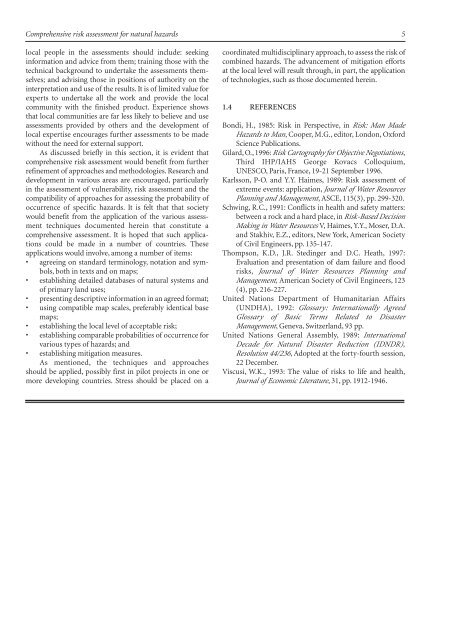Comprehensive Risk Assessment for Natural Hazards - Planat
Comprehensive Risk Assessment for Natural Hazards - Planat
Comprehensive Risk Assessment for Natural Hazards - Planat
Create successful ePaper yourself
Turn your PDF publications into a flip-book with our unique Google optimized e-Paper software.
<strong>Comprehensive</strong> risk assessment <strong>for</strong> natural hazards<br />
local people in the assessments should include: seeking<br />
in<strong>for</strong>mation and advice from them; training those with the<br />
technical background to undertake the assessments themselves;<br />
and advising those in positions of authority on the<br />
interpretation and use of the results. It is of limited value <strong>for</strong><br />
experts to undertake all the work and provide the local<br />
community with the finished product. Experience shows<br />
that local communities are far less likely to believe and use<br />
assessments provided by others and the development of<br />
local expertise encourages further assessments to be made<br />
without the need <strong>for</strong> external support.<br />
As discussed briefly in this section, it is evident that<br />
comprehensive risk assessment would benefit from further<br />
refinement of approaches and methodologies. Research and<br />
development in various areas are encouraged, particularly<br />
in the assessment of vulnerability, risk assessment and the<br />
compatibility of approaches <strong>for</strong> assessing the probability of<br />
occurrence of specific hazards. It is felt that that society<br />
would benefit from the application of the various assessment<br />
techniques documented herein that constitute a<br />
comprehensive assessment. It is hoped that such applications<br />
could be made in a number of countries. These<br />
applications would involve, among a number of items:<br />
• agreeing on standard terminology, notation and symbols,<br />
both in texts and on maps;<br />
• establishing detailed databases of natural systems and<br />
of primary land uses;<br />
• presenting descriptive in<strong>for</strong>mation in an agreed <strong>for</strong>mat;<br />
• using compatible map scales, preferably identical base<br />
maps;<br />
• establishing the local level of acceptable risk;<br />
• establishing comparable probabilities of occurrence <strong>for</strong><br />
various types of hazards; and<br />
• establishing mitigation measures.<br />
As mentioned, the techniques and approaches<br />
should be applied, possibly first in pilot projects in one or<br />
more developing countries. Stress should be placed on a<br />
coordinated multidisciplinary approach, to assess the risk of<br />
combined hazards. The advancement of mitigation ef<strong>for</strong>ts<br />
at the local level will result through, in part, the application<br />
of technologies, such as those documented herein.<br />
1.4 REFERENCES<br />
Bondi, H., 1985: <strong>Risk</strong> in Perspective, in <strong>Risk</strong>: Man Made<br />
<strong>Hazards</strong> to Man, Cooper, M.G., editor, London, Ox<strong>for</strong>d<br />
Science Publications.<br />
Gilard, O., 1996: <strong>Risk</strong> Cartography <strong>for</strong> Objective Negotiations,<br />
Third IHP/IAHS George Kovacs Colloquium,<br />
UNESCO, Paris, France, 19-21 September 1996.<br />
Karlsson, P-O. and Y.Y. Haimes, 1989: <strong>Risk</strong> assessment of<br />
extreme events: application, Journal of Water Resources<br />
Planning and Management, ASCE, 115(3), pp. 299-320.<br />
Schwing, R.C., 1991: Conflicts in health and safety matters:<br />
between a rock and a hard place, in <strong>Risk</strong>-Based Decision<br />
Making in Water Resources V, Haimes, Y.Y., Moser, D.A.<br />
and Stakhiv, E.Z., editors, New York, American Society<br />
of Civil Engineers, pp. 135-147.<br />
Thompson, K.D., J.R. Stedinger and D.C. Heath, 1997:<br />
Evaluation and presentation of dam failure and flood<br />
risks, Journal of Water Resources Planning and<br />
Management, American Society of Civil Engineers, 123<br />
(4), pp. 216-227.<br />
United Nations Department of Humanitarian Affairs<br />
(UNDHA), 1992: Glossary: Internationally Agreed<br />
Glossary of Basic Terms Related to Disaster<br />
Management, Geneva, Switzerland, 93 pp.<br />
United Nations General Assembly, 1989: International<br />
Decade <strong>for</strong> <strong>Natural</strong> Disaster Reduction (IDNDR),<br />
Resolution 44/236, Adopted at the <strong>for</strong>ty-fourth session,<br />
22 December.<br />
Viscusi, W.K., 1993: The value of risks to life and health,<br />
Journal of Economic Literature, 31, pp. 1912-1946.<br />
5

















